Let me share one of my favorite mom hacks for getting kids to eat their veggies: Lumpiang Hubad. As a mom of picky eaters, I've learned that the secret to getting children excited about vegetables is all in the sauce. This "naked lumpia" is basically a deconstructed Filipino spring roll that's become my go-to solution for sneaking more nutrients into my kids' diet.
What makes this recipe a winner? It's that amazing peanut sauce! My kids literally fight over who gets to pour more sauce over their portions. The sweet-savory combo works like magic, they're so focused on the delicious sauce that they don't even realize they're eating jicama, carrots and green beans. Plus, since everything is bite-sized, it's less intimidating for little ones who might be wary of whole vegetables.
It's healthier than traditional lumpia since we skip the wrapper, and you can easily customize the vegetables based on what your family likes. I usually make a big batch because leftovers are perfect for school lunches the next day.
What is Lumpiang Hubad?
Lumpiang Hubad (literally "naked spring roll") is a deconstructed Filipino dish featuring crisp-tender vegetables and tofu dressed in a garlicky peanut sauce. Unlike traditional lumpia wrapped in delicate rice paper, this naked version eliminates the wrapper while preserving the dish's signature flavors and textures.
The medley typically includes jicama (singkamas), carrots, sweet potatoes, garbanzo beans, and green beans, creating a colorful, nutrient-rich base that's elevated by a savory-sweet sauce made with crushed peanuts, garlic, and soy sauce. This healthier adaptation of the classic Filipino appetizer delivers the same satisfying taste with fewer calories and simpler preparation.
Jump to:

Why You'll Love This Recipe
- Healthier Alternative: Without the wrapper, you get all the authentic lumpia flavors with fewer calories
- Customizable: Easy to adapt with your choice of vegetables and proteins
- Quick Preparation: No wrapping needed, saving you valuable time
- Rich in Nutrients: Packed with fresh vegetables and protein-rich ingredients
- Perfect for Gatherings: Serves well as both a main dish or party food
- Dietary-Friendly: Can be made vegetarian, vegan, or gluten-free with simple substitutions
Ingredients
Each ingredient in this recipe serves a specific purpose. Firm tofu provides protein and absorbs the flavorful sauce. Jicama adds a refreshing crunch, while carrots and sweet potatoes contribute natural sweetness and vibrant color.
Garbanzo beans add heartiness and protein, and green beans provide a tender-crisp texture. The aromatic combination of onion, garlic, and fish sauce creates the foundation of authentic Filipino flavor that makes this dish irresistible.

For the Vegetable Mixture:
- 1 package (14 ounces) firm tofu
- 1 onion, peeled and chopped
- 2 cloves garlic, peeled and minced
- 1 large jicama, cut into ½-inch cubes
- 2 large carrots, cut into ½-inch cubes
- 2 large sweet potatoes, cut into ½-inch cubes
- 2 cups garbanzo beans
- 1 cup green beans, bias-cut
- 1 tablespoon fish sauce
- Canola oil for cooking
- Salt to taste
For the Peanut Sauce:
- 2 ½ cups water
- ¼ cup soy sauce
- ¾ cup brown sugar
- ½ teaspoon salt
- 3 tablespoons cornstarch
- 1 cup unsalted peanuts, crushed
- 1 head garlic, minced
- 2 tablespoons peanut butter
Equipment
- Large wok or deep skillet: Essential for sautéing vegetables with enough space for even cooking and tossing
- Sharp knife: Necessary for cutting vegetables into uniform sizes to ensure even cooking
- Cutting board: Provides a stable surface for safe and efficient vegetable preparation
- Measuring cups and spoons: Ensures precise ingredient portions for consistent results
- Medium saucepan: Used specifically for sauce preparation to allow proper thickening
- Colander: Helps drain excess moisture from tofu for better texture when cooking
- Wooden spoons: Allows gentle stirring of vegetables without damaging their shape
- Paper towels: Used for drying tofu to achieve better browning and texture
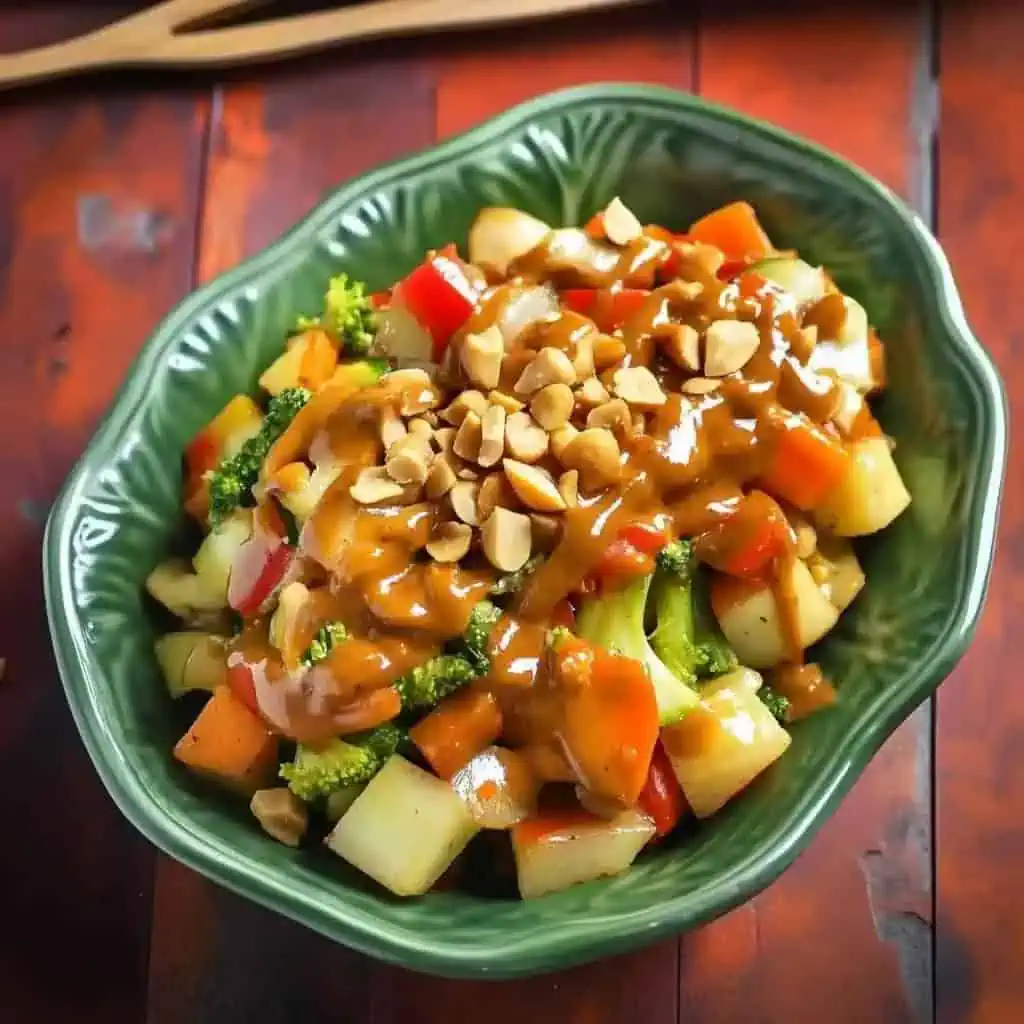
How To Make
- Prepare the tofu: Remove it from the package and drain well. Pat dry with paper towels to remove excess moisture. Cut into small ½-inch cubes. Set your stove to medium heat and warm about 2 tablespoons of oil in your pan. When hot, add the tofu cubes and cook until golden brown, about 5 minutes. Remove and let rest on paper towels to drain excess oil.
- Cook the vegetables: In the same pan, add a fresh tablespoon of oil over medium heat. Add chopped onions and minced garlic, cooking until fragrant, about 2-3 minutes. Pour in the fish sauce and cook for another minute.
- Add root vegetables: Add your diced jicama, carrots, and sweet potatoes to the pan. Pour in a cup of water and bring to a boil. Once boiling, reduce heat to medium-low, cover, and cook until the vegetables are starting to become tender but still firm.
- Complete the vegetable mixture: When the root vegetables are almost done, add garbanzo beans, green beans, and the cooked tofu. Season with salt to taste. Continue cooking until all vegetables are tender-crisp, about 2-3 minutes. Drain the vegetables but reserve the liquid for the sauce.
- Make the peanut sauce: In a pot, combine 2½ cups of the reserved vegetable liquid (or water if needed) with soy sauce, brown sugar, and salt. Heat to medium and bring to a gentle boil, stirring until sugar dissolves. Add crushed peanuts and minced garlic.
- Thicken the sauce: In a small bowl, mix cornstarch with ¼ cup of cold water until smooth. Slowly pour this mixture into your boiling sauce while whisking continuously to prevent lumps. Continue stirring until the sauce thickens. Add the peanut butter and stir until completely incorporated and smooth.
- Serve: Place the vegetable mixture on a plate or bowl, pour the warm peanut sauce over the top, and sprinkle with extra crushed peanuts and minced garlic. Serve immediately while still warm.

Tips from Lola's Kitchen
- Toast the peanuts before crushing for deeper, more complex flavor
- Cut vegetables in similar sizes to ensure they cook evenly
- Save the vegetable cooking liquid for the sauce – it adds wonderful umami flavor
- Always use fresh garlic, never pre-minced, for the most authentic taste
- Let tofu drain for 30 minutes before cooking for improved texture
- Test vegetable doneness with a fork – they should be tender but still have some bite
- Warm plates before serving to keep the dish at the perfect temperature longer
Substitutions
- Tofu: Can be replaced with ground pork or shrimp for a non-vegetarian version
- Fish sauce: Use salt for a vegetarian version
- Peanut butter: Substitute with tahini for those with peanut allergies
- Sweet potato: Regular potato or taro work well as alternatives
- Cornstarch: Potato starch or arrowroot powder can be used instead
- Brown sugar: Palm sugar or regular granulated sugar are good substitutes
- Jicama: Can be replaced with water chestnuts for similar crunch
Troubleshooting
Watery Sauce:
- Cook the sauce longer to reduce excess liquid
- Add a bit more cornstarch slurry (1 teaspoon cornstarch mixed with 1 tablespoon cold water)
- Make sure to whisk continuously when adding cornstarch
Mushy Vegetables:
- Reduce cooking time and maintain slightly higher heat
- Cook vegetables in batches according to density (root vegetables first)
- Ensure vegetables are cut uniformly for even cooking
Bitter Sauce:
- Use fresh garlic and avoid browning it
- Make sure brown sugar is fully dissolved
- Adjust sweetness by adding more sugar if needed
Tough Tofu:
- Use fresh oil when frying tofu
- Maintain proper temperature (medium heat)
- Consider using soft or medium-firm tofu for a different texture
- Press tofu properly before cooking to remove excess moisture
Storage & Reheating
Storage:
- Store vegetables and sauce separately in airtight containers in the refrigerator
- Vegetables will keep for 3-4 days
- Sauce can be refrigerated for up to 5 days
- Not recommended for freezing as textures will change
Reheating:
- Vegetables: Quickly stir-fry for 2-3 minutes or microwave for 1-2 minutes
- Sauce: Reheat over low heat, adding a bit of water if needed to adjust consistency
- Heat to internal temperature of 165°F for food safety
- Only reheat what you plan to consume immediately
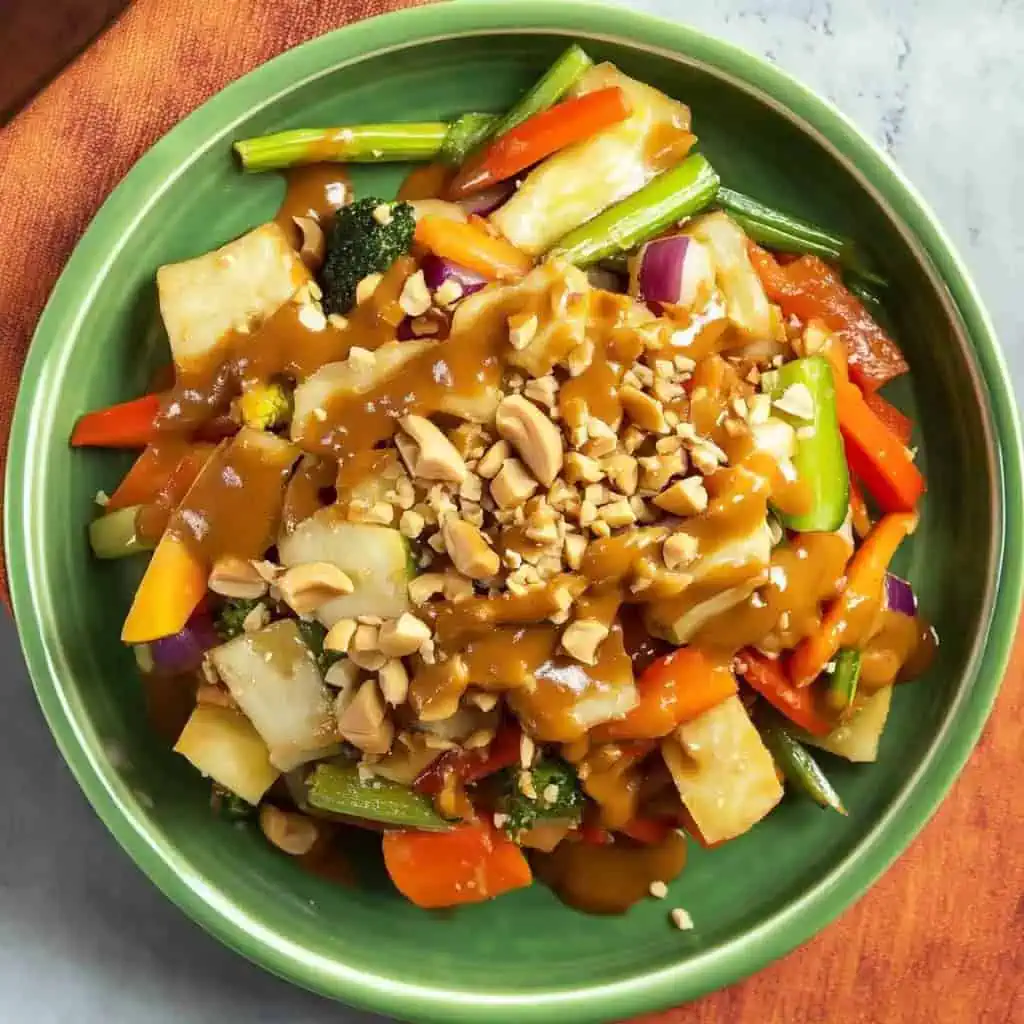
FAQ
Can I make this dish ahead of time?
Yes, you can prepare all components separately up to 2 days ahead. Store vegetables and sauce in separate containers in the refrigerator and assemble just before serving for the best texture and flavor.
Is this recipe gluten-free?
Not in its original form, but you can easily make it gluten-free by substituting tamari for the soy sauce.
How do I know when the vegetables are properly cooked?
They should be bright in color and slightly crisp when bitten into – not too soft or mushy. This usually takes about 5-7 minutes of cooking, depending on the size of your vegetable cuts.
Can I freeze this dish for later?
Freezing is not recommended as the vegetables will lose their crisp texture when thawed. This dish is best enjoyed fresh.
How spicy is traditional Lumpiang Hubad?
The traditional version is mild and not spicy at all. If you prefer heat, you can add fresh chilies or chili garlic sauce to the peanut sauce.
Can I add meat to this recipe?
Absolutely! Ground pork, chicken, or shrimp make excellent additions. Cook the meat first, then add the vegetables.
What's the best way to serve Lumpiang Hubad for a party?
Create a DIY station with the vegetable mixture, sauce, and toppings in separate serving bowls so guests can assemble their own portions.
How long does the sauce keep in the refrigerator?
The peanut sauce will keep well for up to 5 days when stored in an airtight container in the refrigerator.
Related
Looking for other recipes like this? Try these:

Lumpiang Hubad (Naked Filipino Spring Roll)
Equipment
- Large wok or deep skillet (kawali) for sautéing vegetables
- Sharp knife (kutsilyo) for uniform vegetable cuts
- Cutting board (Sangkalan) for prep work
- Measuring cups and spoons (Panukat) for precise ingredients portions
- Medium saucepan for sauce preparation
- Colander (salaan) for draining tofu
- Wooden spoons (sandok) for gentle stirring
- Paper towels for drying tofu
Ingredients
For the Vegetable Mixture (Gulay):
- 1 package 14 ounces firm tofu (tokwa)
- 1 onion sibuyas, peeled and chopped
- 2 cloves garlic bawang, peeled and minced
- 1 large jicama singkamas, cut into ½-inch cubes
- 2 large carrots karot, cut into ½-inch cubes
- 2 large sweet potatoes kamote, cut into ½-inch cubes
- 2 cups garbanzo beans garbanzos
- 1 cup green beans sitaw, bias-cut
- 1 tablespoon fish sauce patis
- Canola oil for cooking
- Salt asin at paminta to taste
For the Peanut Sauce (Sarsa):
- 2 ½ cups water tubig
- ¼ cup soy sauce toyo
- ¾ cup brown sugar asukal na pula
- ½ teaspoon salt asin
- 3 tablespoons cornstarch corn starch
- 1 cup unsalted peanuts mani, crushed
- 1 head garlic bawang, minced
- 2 tablespoons peanut butter
Instructions
- First, prepare your tofu. Remove it from the package and drain well. Pat it dry with paper towels to remove excess moisture. Cut the tofu into small ½-inch cubes. Set your stove to medium heat (180°C/350°F) and warm about 2 tablespoons of oil in your pan. When the oil is hot, add the tofu cubes and cook them until they turn golden brown, about 5 minutes. Once done, take them out and let them rest on paper towels to drain excess oil.
- Now let's cook the vegetables. In the same pan, add a fresh tablespoon of oil over medium heat (175°C/350°F). Add your chopped onions and minced garlic, cooking them until you can smell their lovely aroma, about 2-3 minutes. Pour in the fish sauce and let it cook for a minute.
- Add your diced singkamas, carrots, and sweet potatoes to the pan. Pour in a cup of water and wait for it to start bubbling (100°C/212°F). Once it's bubbling, turn down the heat to medium-low (150°C/300°F), put the lid on, and let it cook until the vegetables are starting to get tender but still firm.
- When the root vegetables are almost done, add your garbanzo beans, green beans, and the cooked tofu. Sprinkle in some salt and pepper to taste. Keep cooking until all the vegetables are tender but still have a nice crunch. This should take about 2-3 minutes. When done, drain the vegetables but save the liquid – we'll use it for the sauce.
- Time to make your peanut sauce. In a pot, mix 2½ cups of the reserved vegetable liquid (or water if you don't have enough) with the soy sauce, brown sugar, and salt. Turn the heat to medium and let it come to a gentle boil (100°C/212°F), stirring until the sugar dissolves. Add your crushed peanuts and minced garlic.
- In a small bowl, mix your cornstarch with ¼ cup of cold water until smooth. Slowly pour this mixture into your boiling sauce while whisking continuously to prevent lumps. Keep stirring until the sauce thickens. Finally, add the peanut butter and stir until it's completely mixed in and your sauce is smooth.
- To serve, place your vegetable mixture on a plate or bowl, pour the warm peanut sauce over the top, and sprinkle with extra crushed peanuts and minced garlic. Serve right away while everything is still warm.
Tips from Lola's Kitchen
- Toast the peanuts before crushing for deeper flavor
- Cut vegetables in similar sizes for even cooking
- Save vegetable liquid for the sauce - it adds umami
- Use fresh garlic, never pre-minced
- Let tofu drain for 30 minutes before cooking
- Test vegetable doneness with a fork - they should be tender but still crisp
Nutrition
The Story Behind Lumpiang Hubad
Lumpiang Hubad, which literally translates to "naked spring rolls" in Filipino, represents the ingenious evolution of the beloved Filipino lumpia. This deconstructed version emerged from the health-conscious kitchens of Metro Manila in the 1980s, as urban professionals sought lighter alternatives to traditional fried lumpia. The dish beautifully preserves the essence of Filipino fresh lumpia (lumping sariwa) while eliminating the rice paper wrapper, making it a perfect choice for those watching their carbohydrate intake.
The history of this dish is deeply intertwined with the story of Filipino street food and home cooking. Traditional lumpia, which arrived in the Philippines through Chinese traders centuries ago, has always been a staple of Filipino cuisine. However, the "naked" version showcases the Filipino talent for adapting and reimagining classic recipes. The star of this dish – the peanut sauce or sarsa – draws from both Chinese and Malay influences, reflecting the multicultural heritage of Filipino cooking.
In modern Filipino households, Lumpiang Hubad has gained popularity not just as a healthy alternative, but as a practical solution for busy families. The dish embodies the Filipino value of "tipid" (resourcefulness) as it transforms simple vegetables into a satisfying meal. It's particularly popular during Lent, when many Filipino Catholics observe meatless Fridays, and has become a staple in contemporary Filipino restaurants showcasing healthier versions of classic dishes.
What makes this dish truly special is its versatility. While the traditional version features ubod (heart of palm) as the main ingredient, home cooks across the Philippines have adapted the recipe to use locally available vegetables. From the singkamas (jicama) of Luzon to the sayote (chayote) of the Cordilleras, each region has its own delicious interpretation. The constant element remains the rich, peanutty sauce, which ties all the ingredients together in a harmonious blend of sweet, savory, and umami flavors.
Today, Lumpiang Hubad stands as a testament to the evolution of Filipino cuisine – honoring traditional flavors while embracing modern dietary preferences. Whether served at family gatherings, office potlucks, or trendy health-food restaurants, this dish continues to win hearts with its perfect balance of taste and nutrition.
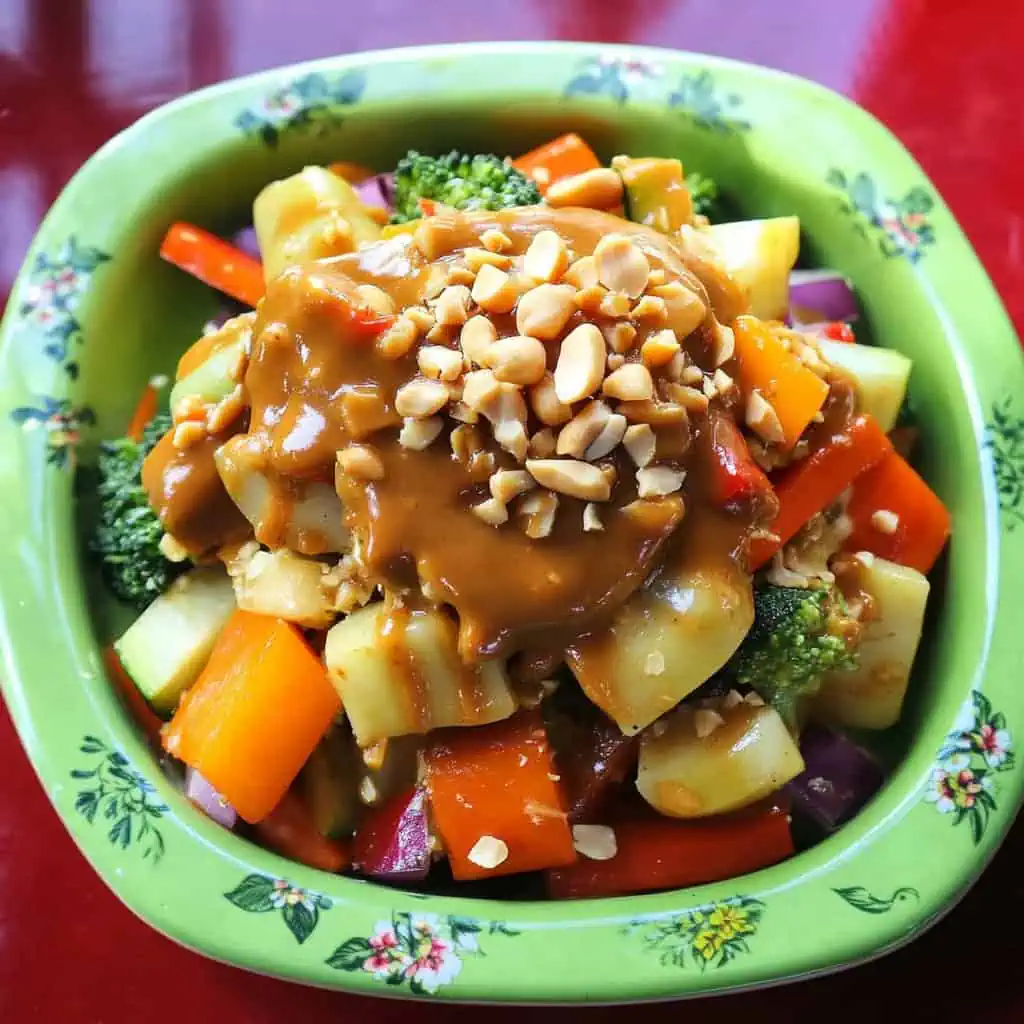

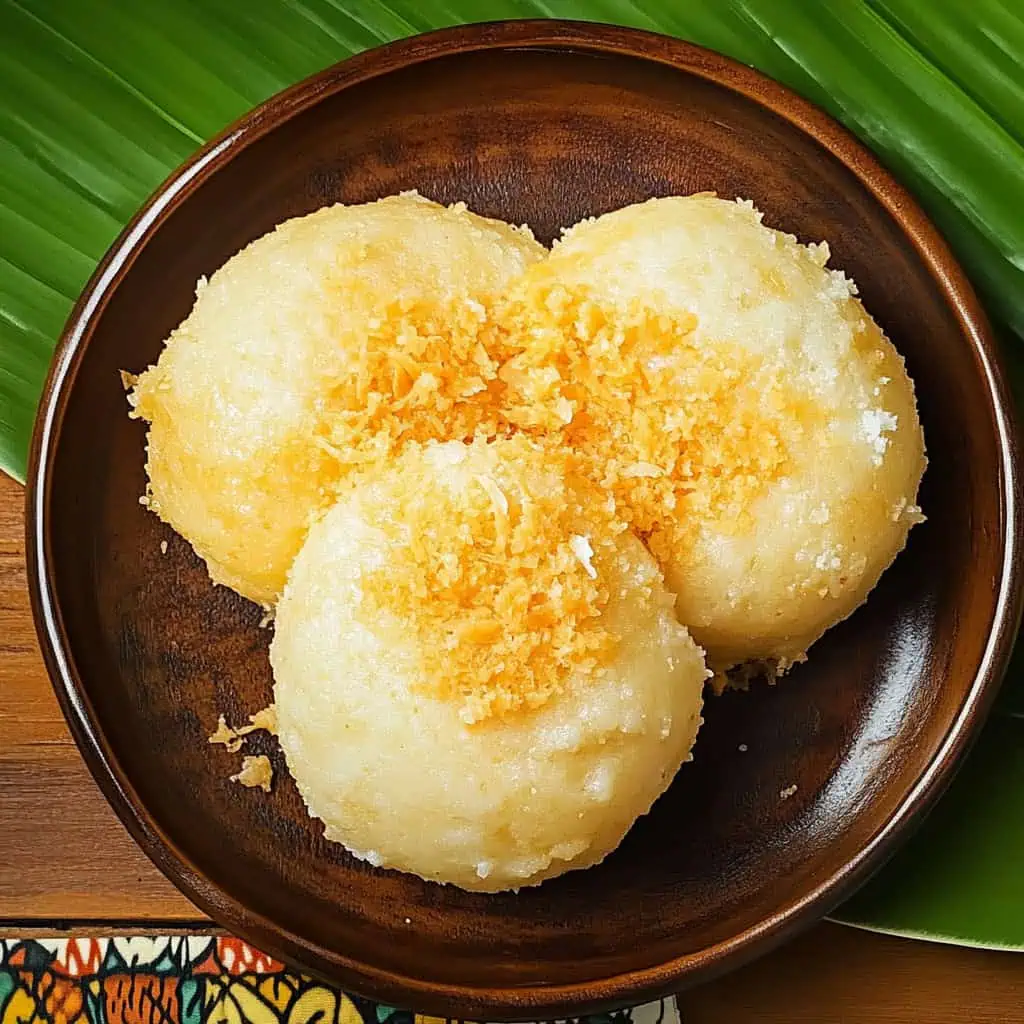
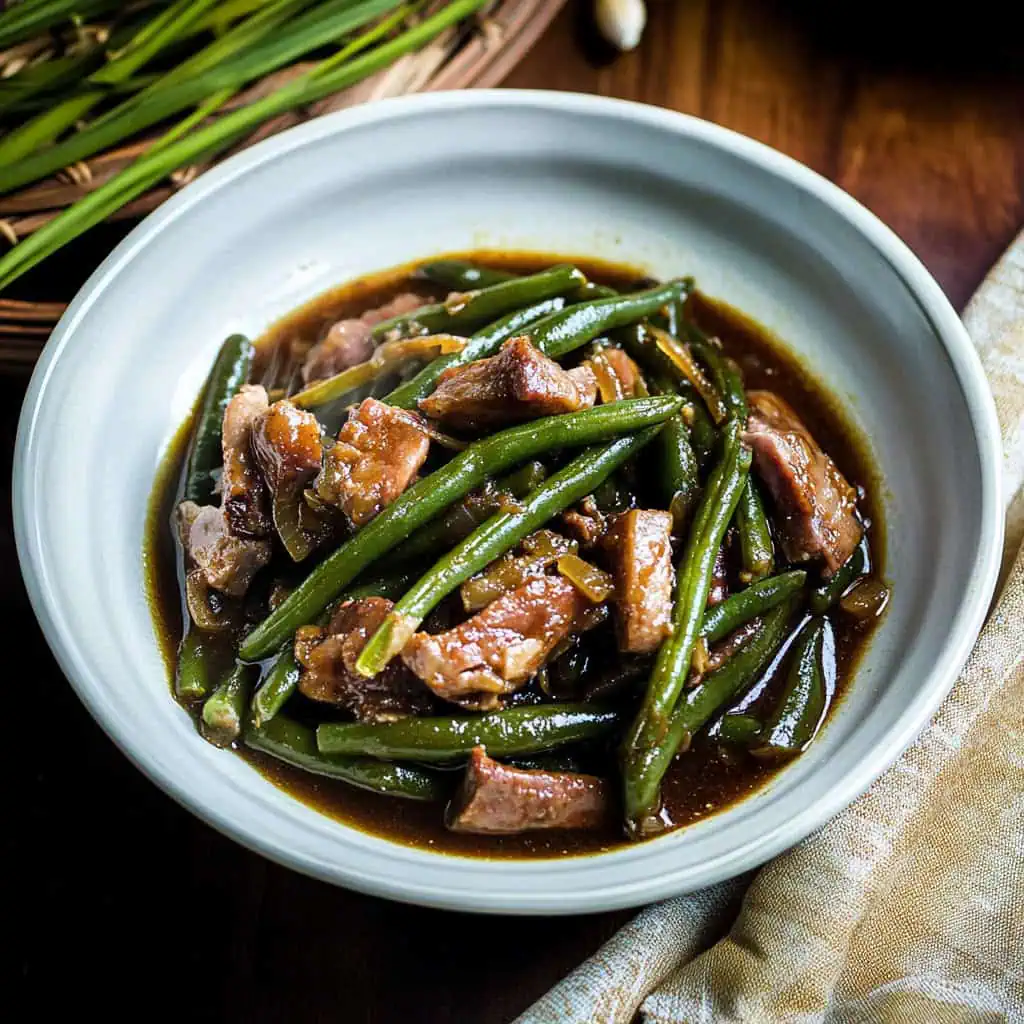
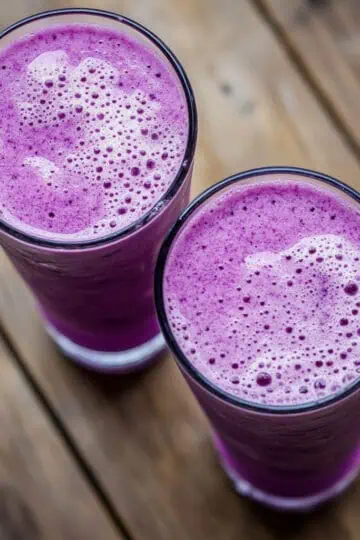





Comments
No Comments